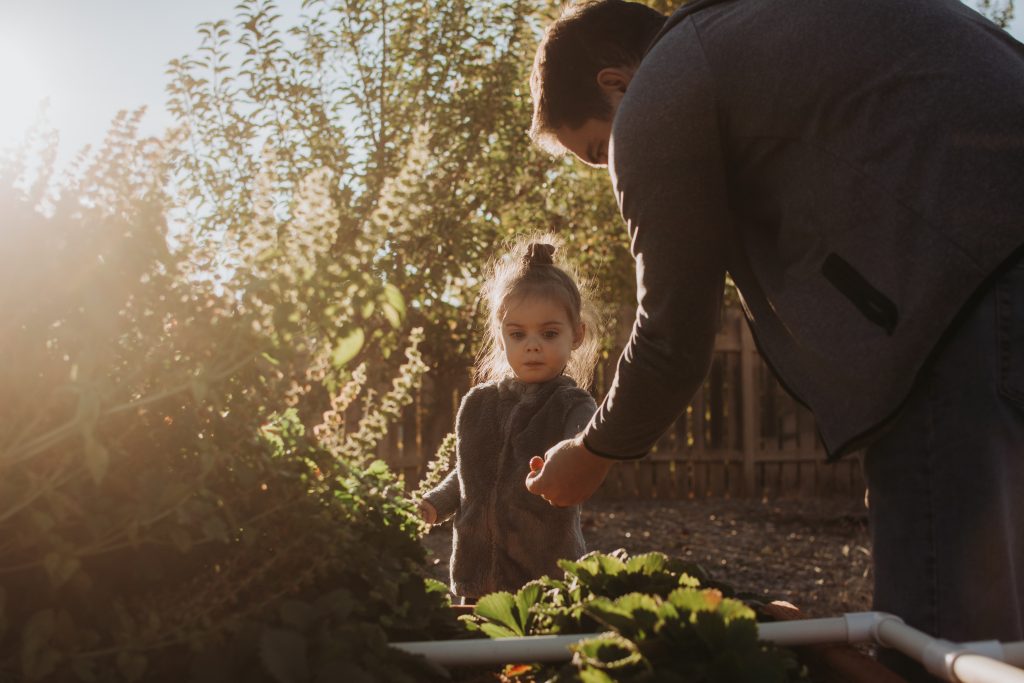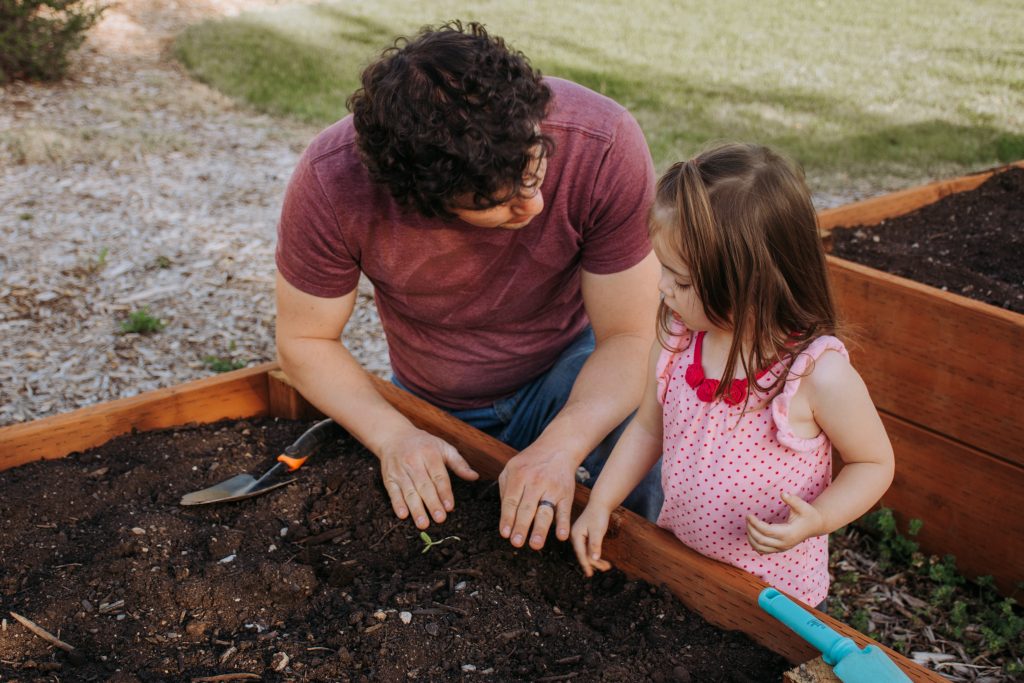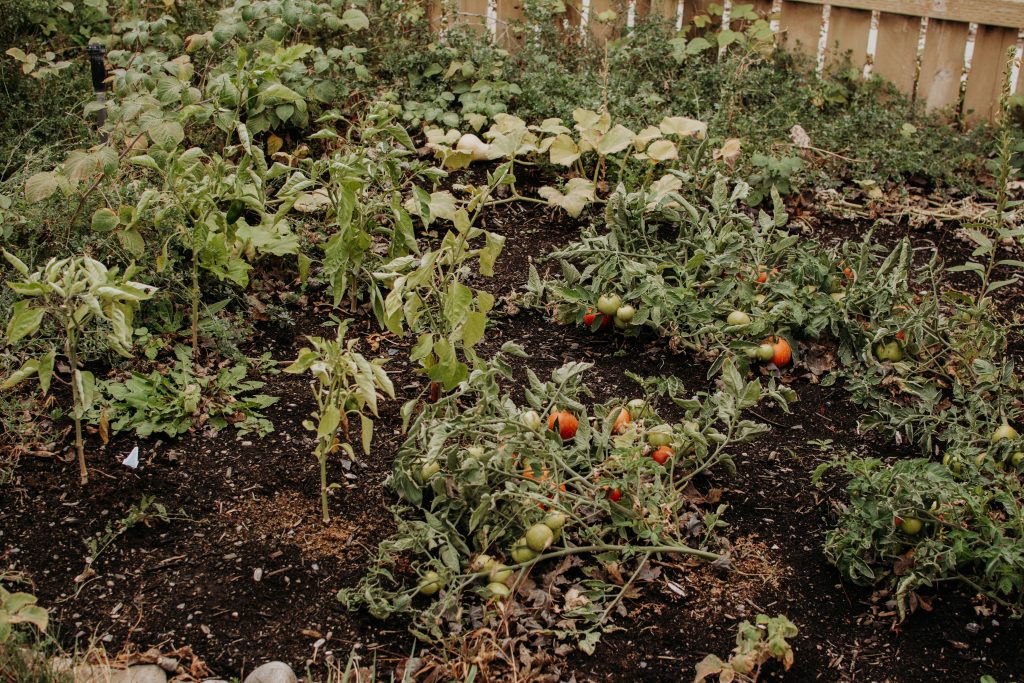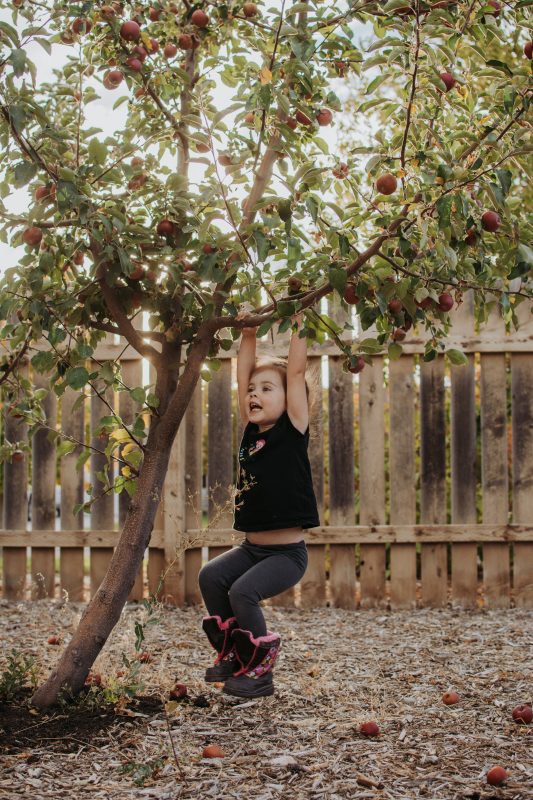
Here in Northern Utah, the nights are getting COLD, and the days are pretty brisk as well (we’ve been around 45 degrees for a lot of today). As it’s clear that our growing season is quickly coming to a close, and I’ve been harvesting the last of our vegetables and trying to savor the joy that comes from being able to go out to the back with a pair of scissors and cut fresh herbs whenever I so desire, I’ve been thinking about how much we’ve learned about yard care and gardening over the past 15 months or so of being homeowners.
While we did participate in a community vegetable garden for two years before (and dabbled in container gardening at both of our apartments), there wasn’t a whole lot of growth and knowledge that came from that since the community garden was largely run by other people (we just had to show up to plant stuff, occasionally weed, and then harvest–we didn’t have to worry about watering or soil care or anything) and the container gardens were…um, usually pretty sad. Since moving to our own place, Matt and I have had enormous amounts of motivation to create the kind of yard we both envision, as well as prepare ourselves now to own a future homestead (a big dream of both of ours).
Although we both really love a lot of things about gardening, we don’t always have a ton of time to do much of the daily upkeep that a garden requires, which is how we came across a lot of the hacks in this post. Now, I know you seasoned gardeners will likely be horrified at these suggestions (because for many of them, we absolutely know that we are not employing the “best” way), but for us, many of these lessons learned have saved us countless hours of labor while still producing a good result, which is why I’m going to pass them on.
10 Lazy Gardener Hacks + Tricks
1. Plants (ultimately) love to be pruned, and while there is certainly a “better” way to prune most shrubs and trees, often pruning at ALL is preferable to doing nothing.
The people who lived in the house before us didn’t seem to be big on pruning, at least as far as we could tell–the apple trees in the back hadn’t been pruned for probably years and years, and the shrubs in the front of our home were wildly overgrown. With just a few VERY basic pruning concepts that my mom mentioned to us (like that you always want to cut out totally dead stalks, that most shrubs you want to cut into a wide bowl shape, and that you don’t want branches to cross each other), we went at it!
While our pruning-happy ways occasionally got us into trouble (like that we cut off almost all of this year’s growth on our blackberry bush on accident because we didn’t realize that the branches with only leaves on them are actually NEXT year’s berries), we were far and away pleasantly surprised that everything we pruned (even and especially all the shrubs we were SURE we OVER-pruned) totally thrived under the treatment. This was true for the big things like the fruit trees, the medium things like the lilac and forsythia bushes, and the small things like the flowers in our containers on the front porch (which I cut down/pinched off when they got scrubby or dead-looking).
So, while you *could* spend hours upon hours educating yourselves on the “correct” or “best” way to prune everything, sometimes it’s better just to have at it and hope for the best.

2. You actually CAN plant things in straight compost (and they’ll do great!).
When I did the post about the raised garden beds we built back in April of this year, I asked people to weigh in on whether or not we’d made a huge mistake by filling our beds solely with compost we’d bought for dirt cheap (ha ha, couldn’t resist) at the local landfill. EVERY SINGLE PERSON (except the one friend who suggested the idea to us in the first place) told us that our plants would not survive, that the soil was chemically too “hot” for any kind of growth, that we’d be better off mixing other things into it before we even attempted putting our seedlings in…etc. etc.
Well, guess what? Basically everything we planted except some of our seedlings (more on those in a minute) THRIVED in the compost. In fact, our garden beds produced literally the biggest marigold bushes (I can’t even call them plants because of their huge size) I’d ever seen, not to mention herbs that were determined to take over the world.
So, unless a particularly finicky plant reeeeally needs a different kind of soil, we will ALWAYS be going the straight compost route as it’s the cheapest option and ridiculously easy.

3. Growing plants from seeds is actually pretty tricky (or can be).
Because we were trying to be as cost-effective as possible, we decided to try and grow most of our desired vegetable and flower pants from seeds this year. Nearly all of the seedlings did really well…at first. But, thanks to our haphazard attempts at trying to harden them off before transplanting, the one day (literally) we didn’t water, and the super strong canyon winds that they had to contend with once they were outside in the ground…well, we had all of TWO plants survive that we had transplanted from inside the house (out of a couple hundred seedlings).
On the other hand (and somewhat surprisingly), MOST of the seeds that we planted directly outside (in late May or early June, once we were out of the danger of frost) did pretty well. So for now, we’re going to forget trying to plant stuff inside (since our outside growing season is decently long enough to actually get a good yield) and just plant all our seeds directly outside next year.
4. It’s healthier for your lawn not to cut it too short or too often.
Last summer, my mom gave us a couple lawn fertilization treatments as a housewarming present, and one of the first things the guy said when he came to treat our lawn was that we were cutting our grass too short, which was why it wasn’t retaining water as well and looking dry and scrubby. Once we raised the mower up an inch or two and started mowing slightly less often, the lawn looked a ton better (and that continued to be true this summer too, even when we didn’t do the treatments again).

5. You really DO need to stake tomato plants.
I don’t know why we didn’t do this (since we’d always done it before when we planted tomato plants in our community garden), but this year it became frustratingly apparent that we really could not afford to skip this next year, as our tomato crop largely had to be chucked because of the wet-rot bottoms they got from touching the ground (not to mention all the worms that were able to get in so easily because the tomatoes weren’t up high enough).
We will not make this mistake again, as it was largely what killed my salsa-making ambitions this year.

6. Apple trees that grow up from offshoots or fallen apples grow into wild apple trees, which are NOT good. However, the tree can still be saved!
We had heard (from the previous owners, I think?) that the two apple trees in the back had maybe grown up from offshoots. Apparently, there used to be four apple trees in that side yard, and some of the previous owners cut them all down one year. However, they allowed two particularly robust offshoots to just keep growing when they came back up, which was what resulted in the two trees we currently have. I had heard that the trees might not be good if the story were true, but we weren’t sure.
This year, both trees produced quite a few apples, but then we lost all of them on the one tree before we could try them at all, and then we took one of the specimens from our west-most tree to our favorite local apple orchard to see if they could identify what kind of apple tree it was. Well, the news was as we feared–within a minute or so, the orchard owner had corroborated with another apple expert and confirmed that we had a Red Delicious tree that had gone wild and was therefore no good.
In the good news department, she told us that her husband was an expert when it came to grafting apple trees and that she was sure he would be able to help us graft a new variety onto our existing tree, which would mean that we could use the tree’s existing strong root system and get tame (read: good) fruit much faster. We’ll be looking into that ASAP now that we know our trees are no good, especially since it will literally save us YEARS (as it takes much longer to plant an entirely new tree and wait for that to produce fruit than it does to simply graft another cutting onto the current one).
Bonus lessons with fruit trees: when buying new ones, it’s MUCH cheaper to buy them when they’re what’s called “bare root” trees (aka, not planted into a pot for selling). We learned this while buying our new apricot and peach trees this spring.
7. Raised garden beds are GREAT for people who aren’t good at keeping up on weeds regularly (*ahem*).
We had debated about whether or not we wanted our raised garden beds to be two boards high or just one (for cost savings), but we decided to bite the bullet and go for the doubly high beds since we knew that keeping up on weeds is NOT one of our strong suits. WE WERE NOT SORRY! We didn’t see a single weed in either of our garden beds all season, and the increased height made it exceedingly easy to check the progress of our plants while staying totally comfortable (i.e., no more aching-back syndrome for us!).

8. Mulching and composting are the best ways to be lazy(ish) with your gardening, yet get great results.
One of the owners of the company that my husband works for is exceptionally astute when it comes to all things gardening (it helps that some of his extensive schooling was in the agricultural/horticulture sphere). Anyway, he told us that the best thing we could do for our soil year after year is to skip out on all the fancy-pants (and totally expensive) soil blends at the store and just add loads of compost to our beds annually.
Well, we took what he said directly to heart, and we only cleared out the very tallest of the weeds and covered all the rest with a very (VERY) thick layer of compost. Not only did it immediately take care of most of the existing weeds, but it also made our garden beds look AMAZING, as if we’d spent hours upon hours cleaning them up. Trust me, we will be doing this EVERY YEAR FOR THE REST OF TIME (because, once again, we are not good with weeds, people).
Second, this same boss told us that the best way for us to keep more moisture in our beds (and therefore cut down on watering) as well as control the weed problem in the future was to mulch all our existing plants. Since Matt works at a place that makes food for small animals, there is a lot of natural byproduct that we could get from his work for free to mulch our beds (most of it hay-based). We simply took sacks of this hay and spread it liberally over everything we planted. Sure enough, it helped us need to water less, weed less, and fertilize less, and our plants still did really quite well.
Lesson learned? A little work upfront saved us HOURS of maintenance work down the line. Totally worth it.

9. Peonies are finicky, finicky plants. Also, if you can get starts or transplants from someone’s already-existing (and thriving) perennial plant, THAT’S THE WAY TO GO.
I’ve heard that once you have a thriving peony bush, they will survive for decades and decades and spread and multiply and produce prolifically. However, what I did NOT understand was that it can be a bit tricky to get them to that point in the first place. We planted six (I think) peony bulbs this year and eagerly awaited for them to leaf out and fill in some of the bare areas up in the front of our house.
No go.
Apparently, peonies must be planted at *just* the perfect depth and just the right direction with just the right amount-of-whatever in the soil in order for them to take. Sure, you might get a few leaves to sprout up…but if all the conditions weren’t perfectly met, you will never, ever get flowers.
So our peonies were a flop.
However, we did transplant a TON of perennials from my mom’s and sister’s gardens to save money (and since they were thinning theirs out anyway), and those plants (daylilies, irises, and jupiter’s beard, to name a few) totally thrived. In fact, since they were already well established and strong, we even got most of them to flower for us this year, and it gave our garden beds the look of being much more mature than they really were.
So, if we give peonies a try in the future, we’ll probably see if we can get a transplant of them.
(Update: We ended up doing about six peony transplants during our second year of gardening, and they THRIVED. So, lesson learned: try transplants if at all possible!)
In summary: the quickest (and cheapest) way to a more established garden? Transplanting as many established plants as people will let you have.

10. A great way to remove a huge shrub is to tie it to the back of a truck and then drive away.
One of our last lazy gardening hacks is this little gem! We had two huge shrubs in the front of our house from the pine family that we just really didn’t like. Since both were rather large (reaching almost or even above our roof line), the idea of pruning them down and then trying to dig out the whole root mass was intimidating. So, Matt had the idea to just borrow a coworker’s truck, tie the shrubs to the bumper, and drive off.
And you know what?
It worked brilliantly. Not only did it take all of about five minutes to remove both shrubs, but it also easily removed the entire root system, so we didn’t have to worry about the shrubs growing up in the future.
Lazy gardening for the win.
What are some of your favorite lazy gardening hacks?







